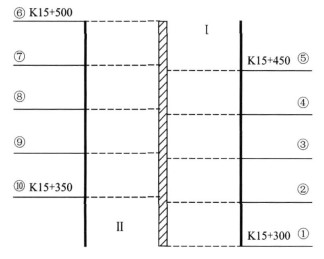Controlling method of segregation for coarse asphalt mixture
-
摘要: 分析了粗粒式沥青混合料的离析特性, 以AC-25C为研究对象, 从集料规格选用、转运施工工艺、摊铺机螺旋分料器工作参数与摊铺方式等方面阐述了其离析控制原理, 并提出粗粒式沥青混合料离析控制方法。研究结果表明: AC-25C沥青混合料应选用S8、S9、S12、S14(S15)、S16等规格的合格集料; 相对于传统施工工艺, 采用沥青混合料转运施工工艺后的摊铺面横向温度变异系数极值从4.39%减小至1.06%, 路面横向不同位置处的通过各筛孔的集料质量通过率变异系数极值从14.65%减小至7.59%, 路面横断面方向各点密度变异系数极值从3.23%减小至1.14%, 路面横向构造深度变异系数极值从28.14%减小至13.79%, 路面横断面方向的渗水系数变异系数极值从89.45%减小至54.54%;为减小离析, 当螺旋分料器的转速和螺距一定时, 物料距轴线的距离应不小于0.75倍的螺距; 当螺旋分料器的转速和物料距轴线的距离一定时, 螺旋分料器的螺距应大致保持为1.3倍的物料距轴线的距离; 并且采用窄幅摊铺方式是降低粗粒式沥青混合料路面离析程度的重要措施。Abstract: The segregation characteristics of coarse asphalt mixture were studied, AC-25C was taken as research object, the controlling principle of segregation was analyzed from the aspects of aggregate selection, material transfer, the operating parameters of paver's distribution room and paving pattern, and a controlling method of segregation was proposed.Study result indicates that for AC-25C asphalt mixture, some qualified aggregates from the specifications of S8, S9, S12, S14(S15) and S16 should be chosen.Contrasted with the conventional construction technology, the transverse temperature variable coefficient's extreme value of paving working face decreases from 4.39% to 1.06%, the mass pass rate variable coefficient's extreme value of aggregate passing every sieve size at the different positions of pavement transect decreases from 14.65% to 7.59%, the transverse density variable coefficient's extreme value of surface course reduces from 3.23% to 1.14%, the extreme value of texture transverse depth decreases from 28.14% to 13.79%, and the transverse permeability coefficient's extreme value of pavement reduces from 89.45% to 54.54%.In order to reduce the occurrence of segregation, when distribution room's thread pitch and rotate speed are fixed, the distance between material and axis should be no less 0.75 times of thread pitch.When distribution room's rotate speed and the distance between material and axis are fixed, distribution room's thread pitch should be about 1.3 times of the distance between material and axis.Narrow-size paving is an important way of maintaining uniform pavement.
-
表 1 使用转运车的沥青混合料的级配分析结果
Table 1. Gradation analysis result of asphalt mixture when using material transfer vehicle

表 2 未使用转运车的沥青混合料的级配分析结果
Table 2. Gradation analysis result of asphalt mixture when no using material transfer vehicle

表 3 筛孔质量通过率与设计值之差
Table 3. Differences between mass pass rates at different positions and design values with different paving methods

-
[1] 彭余华. 沥青混合料离析特征判别与控制方法的研究[D]. 西安: 长安大学, 2006.PENG Yu-hua. Research on characteristics distinguishing and controlling means of the segregation in asphalt mixture[D]. Xi'an: Chang'an University, 2006. (in Chinese) [2] The American Association of State Highway and Transportation Officials, the National Asphalt Pavement Association. Segregation causes and cures for hot max asphal[R]. Washington DC: the American Association of State Highway and Transportation Officials, 1997. [3] Transportation Research Board National Research Council. Segregation in Hot-mix Asphalt Pavements[M]. Washington DC: National Academy Press, 2000. [4] MCGLINCHEY D. Quantying segregation in heaps: an experimental study[J]. Ponder Technology, 2004, 145(2): 106-112. [5] CHANG K G, MEEGODA J N. Micromechanical model for temperature effects of hot-mix asphalt concrete[J]. Transportation Research Record, 1999(1687): 95-103. [6] HSIAU S S, YU H Y. Segregation phenomena in a shaker[J]. Powder Technology, 1997, 93(1): 83-88. doi: 10.1016/S0032-5910(97)03263-4 [7] 李斌, 王雪刚, 赵志军, 等. 沥青路面施工中的离析与防治措施[J]. 武汉理工大学学报, 2007, 29(9): 27-30.LI Bin, WANG Xue-gang, ZHAO Zhi-jun, et al. Research on the segregation prevention of asphalt pavement during construction[J]. Journal of Wuhan University of Technology, 2007, 29(9): 27-30. (in Chinese) [8] 包秀宁, 张肖宁, 吴旷怀, 等. 级配对矿质颗粒体离析的影响研究及应用[J]. 中山大学学报: 自然科学版, 2009, 48(6): 48-53.BAO Xiu-ning, ZHANG Xiao-ning, WU Kuang-huai, et al. Research and application of the gradation impact on mineral granular masses segregation[J]. Acta Scientiarum Naturalium Universitatis Sunyatseni: Natural Science Edition, 2009, 48(6): 48-53. (in Chinese) [9] 唐娴, 王社良, 戴经梁. 沥青混合料离析的评价模型与评价标准[J]. 交通运输工程学报, 2010, 10(2): 1-5. http://transport.chd.edu.cn/article/id/201002001TANG Xian, WANG She-liang, DAI Jing-liang. Evaluated model and standard of segregation for asphalt mixture[J]. Journal of Traffic and Transportation Engineering, 2010, 10(2): 1-5. (in Chinese) http://transport.chd.edu.cn/article/id/201002001 [10] 何志勇, 何清华, 李自光. 沥青混合料转运车性能试验研究[J]. 中国工程机械学报, 2006, 4(3): 344-347. doi: 10.3969/j.issn.1672-5581.2006.03.020HE Zhi-yong, HE Qing-hua, LI Zi-guang. Performance testing of mixed asphalt conveyors[J]. Chinese Journal of Construction Machinery, 2006, 4(3): 344-347. (in Chinese) doi: 10.3969/j.issn.1672-5581.2006.03.020 [11] 田小革, 吕松涛, 郑健龙. 沥青混合料转运车对减轻沥青路面级配离析的作用[J]. 公路交通科技, 2005, 22(6): 21-23.TIAN Xiao-ge, LU Song-tao, ZHENG Jian-long. The effect of asphalt mixture transfer car on asphalt pavement gradation segregation[J]. Journal of Highway and Transportation Research and Development, 2005, 22(6): 21-23. (in Chinese) [12] 陆兆峰, 秦旻, 郭小宏. 沥青混合料流在螺旋布料槽中的运动特征分析[J]. 重庆交通大学学报: 自然科学版, 2009, 28(1): 63-66.LU Zhao-feng, QIN Min, GUO Xiao-hong. Study on moving feature of bituminous mixture flow in distributing room[J]. Journal of Chongqing Jiaotong University: Natural Science, 2009, 28(1): 63-66. (in Chinese) -





 下载:
下载:













